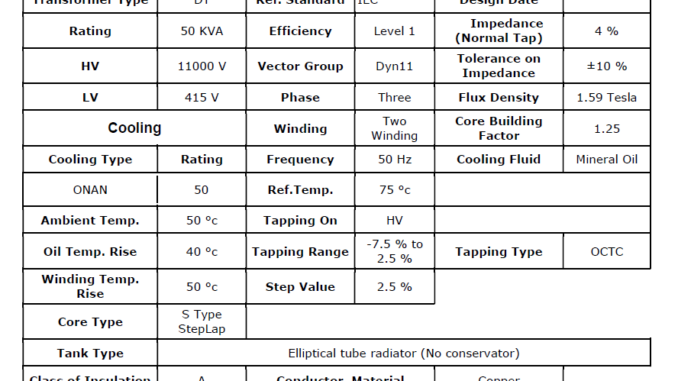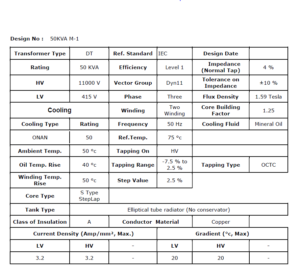
50 KVA transformer design complete calculation involves a comprehensive PDF sheet of calculations and considerations to ensure its efficiency, reliability, and adherence to safety standards. This process requires a meticulous approach, taking into account factors such as core size, winding configurations, insulation, and voltage regulation. In this document, we will delve into the complete design calculations for a 50 KVA transformer, providing step-by-step guidance to facilitate the design process.

Key Design Parameters:
- Design No: M-1
- Transformer Type: Distribution Transformer
- Rating: 50 KVA
- High Voltage Side (Primary Side): 11000 V
- Low Voltage Side: 415 V Phase
- Reference Standard: IEC-60076-1 to 5
- Efficiency: Level 1
- Impedance (Normal Tap): 4%
- Tolerance on Impedance: ±10%
- Vector Group: Dyn11
- Rating Frequency: 50 Hz
- Flux Density: 1.68 Tesla
- Cooling: Cooling Fluid – Mineral Oil
- Winding: Two Winding
- Core Building Factor: 1.25
Thermal Management and Cooling System:
- Cooling Type: ONAN (Oil Natural Air Natural)
- Reference Temperature: 75 °C
- Ambient Temperature: 50 °C
- Oil Temperature Rise: 40 °C
- Winding Temperature Rise: 50 °C
Tapping and Core Features:
- Tapping On: High Voltage Side
- Tapping Type: OCTC (Off-Circuit Tap Changer)
- Tapping Range: -7.5% to 2.5%
- Step Value: 2.5%
- Core Type: S Type StepLap
- Tank Type: The corrugated fin type with conservator
- Class of Insulation: A
Electrical and Material Specifications:
- Conductor Material: Copper
- Current Density (Amp/mm², Max.) LV: 2.8
- Current Density (Amp/mm², Max.) HV: 2.8
- Gradient (°C, Max): 20
Detailed Analysis:
1. Efficiency Level 1:
Transformer M-1 is designed with a Level 1 efficiency rating, emphasizing its commitment to minimizing energy losses during power conversion. This is particularly crucial in applications where energy conservation is paramount. And calculated losses is 120 watt iron and 920 w is copper losses .
2. Impedance (Normal Tap) – 4% with ±10% Tolerance:
The 4% impedance, coupled with a ±10% tolerance, ensures that the transformer maintains stability in varying operating conditions. This design parameter contributes to reliable voltage regulation and load handling capability.
3. Flux Density – 1.68 Tesla:
The specified flux density of 1.68 Tesla aligns with industry standards, indicating an optimal magnetic field strength for efficient energy transfer. This parameter is essential for the transformer’s performance and safety.
4. Core Building Factor – 1.25:
The core building factor of 1.25 reflects an efficient use of materials in constructing the transformer core. This factor influences the transformer’s performance, minimizing losses and promoting longevity.
5. Cooling Fluid – Mineral Oil:
The use of mineral oil as a cooling fluid is a common and effective choice. Mineral oil aids in dissipating heat generated during operation, preventing overheating and ensuring the transformer operates within safe temperature limits.
6. ONAN Cooling Type:
The ONAN cooling type relies on natural convection for heat dissipation. This design choice simplifies maintenance and ensures reliable performance over an extended operational life.
7. Tapping on High Voltage Side with OCTC System:
The tapping feature on the high voltage side, coupled with the Off-Circuit Tap Changer (OCTC) system, provides operational flexibility. This mechanism allows for precise adjustments in voltage levels, accommodating variations in load and network conditions.
8. Tapping Range -7.5% to 2.5% with a Step Value of 2.5%:
The wide tapping range and fine 2.5% step value allow for precise adjustments, ensuring optimal voltage regulation. This feature is critical for adapting to changing load conditions and maintaining a stable electrical network.
9. Core Type S – Type StepLap:
The S Type StepLap core design enhances the transformer’s efficiency by minimizing eddy current losses and improving magnetic flux distribution. This structural innovation contributes to reduced energy wastage and enhanced overall performance.
10. Tank Type – Corrugated Fin Type with Conservator:
The tank design, with corrugated fins and a conservator, is aimed at efficient cooling and insulation. The conservator allows for the expansion and contraction of the transformer oil, preventing air contact and degradation.
11. Class of Insulation – A:
The insulation class A designation signifies the transformer’s ability to withstand a broad range of environmental conditions and electrical stresses. This ensures a robust insulation system that enhances the transformer’s operational life.
12. Conductor Material – Copper:
Copper is chosen as the conductor material due to its excellent conductivity and heat dissipation properties. This selection ensures minimal energy losses and contributes to the overall efficiency and reliability of the transformer.
13. Current Density (Amp/mm², Max.) LV and HV – 2.8:
The specified current density values for both low voltage (LV) and high voltage (HV) windings indicate a balanced design that prioritizes safety and longevity while optimizing for performance.
14. Gradient (°C, Max) – 20:
The maximum gradient of 20°C is a crucial parameter indicating the allowable temperature difference per unit length. This specification influences the transformer’s thermal stability and contributes to its overall reliability.

Leave a Reply